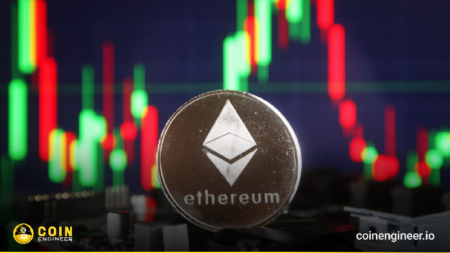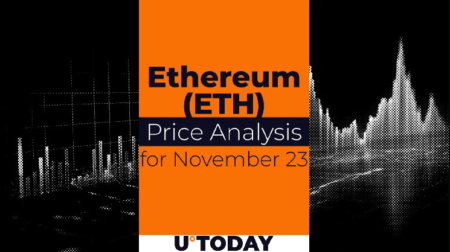The Ethereum blockchain, known for its pivotal role in the cryptocurrency and decentralized application sectors, recently encountered significant disruptions. With the emergence of missing blocks on its mainnet, concerns have been raised regarding the network’s reliability. Ethereum developers are actively investigating the causes behind these issues, aiming to restore stability and maintain the network’s performance integrity.
In related news, Larry Fink, CEO of BlackRock, the world’s largest asset management firm, shared insights into the feasibility of launching an Ethereum ETF, even under the potential classification of Ethereum as a security. This discussion arises amidst ongoing debates on cryptocurrency regulation, specifically the classification efforts by the SEC. Fink’s perspective introduces a significant viewpoint into the conversation on how Ethereum could be integrated into the traditional financial market structure, despite the complex regulatory landscape.
Ethereum Network Disruption Raises Concerns Over Stability
The Ethereum blockchain, a cornerstone of the cryptocurrency world and host to a myriad of decentralized applications, recently encountered a significant disruption. This incident, characterized by missing blocks within its mainnet, has sparked concerns over the network’s stability and overall performance. In response to these events, Ethereum developers have initiated a thorough investigation to unravel the underlying causes of this issue.
Ethereum Explorer Highlights Network Struggles
The disruption was first brought to light by beacon chain.eth, an open-source Ethereum explorer known for its detailed scrutiny of blockchain activities. According to a tweet issued late Wednesday, the explorer highlighted the ongoing challenges faced by the Ethereum network over the past few epochs. “The Ethereum network has been struggling and missing blocks for the past few epochs. Core developers are investigating, but it’s best to monitor your nodes closely,” it noted, emphasizing the importance of vigilance among network participants.
Developer Insights on Network Recovery
This call to vigilance was underscored by contributions from Terence.eth, a developer deeply embedded in the Ethereum community. In the early hours of Mar. 28, Terence.eth provided a glimmer of hope, suggesting that the mainnet was on its way to resuming normal operations. He assured the community that no immediate action was required from any CL or EL client at the moment, emphasizing the non-necessity of immediate action from clients. When probed about potential causes, he indicated an issue with the blob sidecar’s release process from the relayer, noting that the problem had been exacerbated by an accumulation of more blobs.
Uncovering Network Vulnerabilities
Interestingly, this isn’t an isolated incident. The Ethereum network has faced other threats, notably a vulnerability that spanned from the Merge until the Dencun hard fork. This vulnerability related to the different message size limits set for RPC communication, designed as a safeguard against denial-of-service (DOS) attacks. On Feb. 7, it came to light that it was feasible to create a block exceeding the 5MB limit, filled with transactions that, while individually under the 128KB limit and cumulatively below 30 million gas, could potentially destabilize the network. This flaw could enable an attacker to flood the network with high-paying transactions, leading to a situation where the majority of nodes (primarily geth) would reject blocks that a minority might accept, resulting in forked blocks and loss of rewards for the proposers. Fortunately, this issue has since been addressed and resolved in the client updates.
Recent Upgrades and Their Impact
The timing of these disruptions is particularly notable, coming shortly after the Ethereum mainnet’s Dencun upgrade. This upgrade, implemented in early March, introduced ephemeral data blobs with EIP-4844, a component of the “protodanksharding” mechanism aimed at enhancing network efficiency and scalability. While it remains unclear if the recent issues are directly linked to this upgrade, the coincidence has raised questions within the Ethereum community.
As the investigation unfolds, the Ethereum developers are expected to provide further updates and possibly a detailed post-mortem analysis. Such transparency and responsiveness are crucial for maintaining trust and stability within the Ethereum ecosystem, especially as it continues to evolve and adapt to the growing demands of the decentralized world. With the network’s resilience tested once more, the community waits eagerly for resolutions that will fortify Ethereum against future disruptions, ensuring its position as a leading blockchain platform for innovation and development.
BlackRock CEO Larry Fink Considers Ethereum ETF Potential Amid Security Classification Debate
In a revealing interview with Fox Business, Larry Fink, CEO of BlackRock, the world’s largest asset manager with assets under management worth approximately $9.1 trillion, opened up about the future prospects of Ethereum in the financial markets. Contrary to what many might assume, Fink suggested that the potential classification of Ethereum as a security would not hinder the possibility of launching an Ethereum exchange-traded fund (ETF). This perspective comes amid growing discussions and speculation over the regulatory treatment of cryptocurrencies in the United States.
The Ethereum ETF Prospect
Fink’s comments have stirred considerable interest within the cryptocurrency and investment communities. He posited that the classification of Ethereum as a security, a matter currently under significant scrutiny by the Securities and Exchange Commission (SEC), would not be “deleterious.” His stance introduces a nuanced view into the ongoing debate about the regulatory future of cryptocurrencies and their integration into traditional financial systems.
ETF analyst Nate Geraci noted Fink’s remarks on Ethereum as “highly interesting,” interpreting them as a sign that the SEC is earnestly working towards classifying the second-largest cryptocurrency by market capitalization as a security. Despite skepticism about the SEC approving an Ether-based spot ETF as soon as May, Geraci sees potential for such a product in the aftermath of a security classification. He suggests that the SEC’s prior approval of Ethereum futures ETFs could pave the way for this development, allowing the regulator to “thread the needle” in its approach to cryptocurrency regulation.
SEC vs. CFTC: A Regulatory Tug-of-War
The SEC’s reported efforts to classify Ethereum as a security contrast with the Commodity Futures Trading Commission’s (CFTC) recognition of Ether as a commodity. This regulatory dichotomy highlights the complex landscape that cryptocurrencies navigate within the U.S. financial regulatory framework. Moreover, the Ethereum Foundation, a pivotal entity in the development and promotion of the Ethereum ecosystem, is reportedly under investigation, further complicating the regulatory outlook for Ethereum.
Bitcoin’s Bright Horizon
During the same interview, Fink expressed a bullish outlook on Bitcoin, citing unexpected massive retail demand as a significant factor. Under Fink’s leadership, BlackRock has ventured into the cryptocurrency space, with its Bitcoin trust, IBIT, setting records as the fastest-growing ETF, underscoring the asset manager’s successful foray into digital assets.
However, the enthusiasm for Bitcoin does not seem to extend to Ethereum and other altcoins, according to Robert Mitchnick, head of digital assets at BlackRock. Mitchnick pointed out the lack of demand for Ethereum and virtually no interest in other altcoins among their clients, positioning Bitcoin as the primary focus for the financial behemoth.
Larry Fink’s insights into the possibility of an Ethereum ETF and his bullish stance on Bitcoin reflect the evolving narrative around cryptocurrencies in the investment world. As regulatory bodies like the SEC and CFTC navigate the complex terrain of digital assets, the comments from industry leaders like Fink provide a glimpse into the potential future of cryptocurrencies in mainstream finance. With BlackRock at the forefront of integrating digital assets into its offerings, the asset management giant’s moves are closely watched by investors and regulators alike, potentially setting the tone for the industry’s direction in the coming years.
Read the full article here









